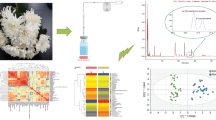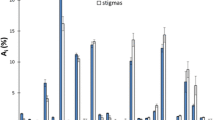Abstract
The aroma compounds in the Chinese vinegar has been profiling by the technology of Headspace solid phase microextraction (HS-SPME) hybrid with gas chromatography mass spectrometry (GC-MS). Thirteen compounds were selected as the key aroma compounds to discriminate two protected geographical origin (PGI) Chinese vinegars named Shanxi extra-aged vinegar and Zhenjiang vinegar by using principal component analysis. The results demonstrate that volatile organic components as the markers combined with the appropriate chemometrics method can be used for PGI Chinese vinegar discrimination with good reliability.




Similar content being viewed by others
References
Aceña L, Vera L, Guasch J, Busto O, Mestres M (2011) Chemical characterization of commercial sherry vinegar aroma by headspace solid-phase microextraction and gas chromatography−olfactometry. J Agric Food Chem 59(8):4062–4070
Callejón RM, Morales ML, Ferreira ACS, Troncoso AM (2008a) Defining the typical aroma of sherry vinegar: sensory and chemical approach. J Agric Food Chem 56(17):8086–8095
Callejón RM, Morales ML, Troncoso AM, Silva Ferreira AC (2008b) Targeting key aromatic substances on the typical aroma of sherry vinegar. J Agric Food Chem 56(15):6631–6639
Casale M, Armanino C, Casolino C, Oliveros CC, Forina M (2006a) A chemometrical approach for vinegar classification by headspace mass spectrometry of volatile compounds. Food Sci Technol Res 12(3):223–230
Casale M, Sáiz Abajo MJ, González Sáiz JM, Pizarro C, Forina M (2006b) Study of the aging and oxidation processes of vinegar samples from different origins during storage by near-infrared spectroscopy. Anal Chim Acta 557(1):360–366
Castro Mejías R, Natera Marín R, de Valme García Moreno M, García Barroso C (2002) Optimisation of headspace solid-phase microextraction for analysis of aromatic compounds in vinegar. J Chromatogr A 953(1):7–15
Chen JC, Chen QH, Guo Q, Ruan S, Ruan H, He GQ, Gu Q (2010) Simultaneous determination of acetoin and tetramethylpyrazine in traditional vinegars by HPLC method. Food Chem 122(4):1247–1252
Cocchi M, Durante C, Marchetti A, Armanino C, Casale M (2007) Characterization and discrimination of different aged ‘Aceto Balsamico Tradizionale di Modena’ products by head space mass spectrometry and chemometrics. Anal Chim Acta 589(1):96–104
Damascelli A, Palmisano F (2013) Sesquiterpene fingerprinting by headspace SPME-GC-MS: preliminary study for a simple and powerful analytical tool for traceability of olive oils. Food Anal Methods 6(3):900–905
Del Signore A (2001) Chemometric analysis and volatile compounds of traditional balsamic vinegars from Modena. J Food Eng 50(2):77–90
Durán GE, Chinnici F, Natali N, Marin RN, Riponi C (2008) Solid-phase extraction method for determination of volatile compounds in traditional balsamic vinegar. J Sep Sci 31:3030–3036
Herrmann M, Klotzbücher B, Wurzbacher M, Hanke S, Kattein U, Back W, Becker T, Krottenthaler M (2010) A new validation of relevant substances for the evaluation of beer aging depending on the employed boiling system. J Inst Brew 116(1):41–48
Lu ZM, Xu W, Yu NH, Zhou T, Li GQ, Shi JS, Xu ZH (2011) Recovery of aroma compounds from Zhenjiang aromatic vinegar by supercritical fluid extraction. Int J Food Sci Technol 46:1508
Luo MZ, Zheng YJ, Xiong C, Li BF, Chen SJ, Bai WL, Zeng YT, Li YL, Zhang XG (2013) A geographical discrimination of Shanxi extra aged vinegars using polyalcohols as the discriminators. J AOAC Int 96(5):1048–1053
Natera Marín R, Castro Mejías R, de Valme García Moreno M, García Rowe F, García Barroso C (2002) Headspace solid-phase microextraction analysis of aroma compounds in vinegar: validation study. J Chromatogr A 967(2):261–267
Pizarro C, Esteban-Díez I, Sáenz-González C, González-Sáiz JM (2008) Vinegar classification based on feature extraction and selection from headspace solid-phase microextraction/gas chromatography volatile analyses: a feasibility study. Anal Chim Acta 608(1):38–47
Wang AL, Song HL, Ren CZ, Li ZG (2012) Key aroma compounds in Shanxi aged tartary buckwheat vinegar and changes during its thermal processing. Flavour Fragance J 27:47–53
Xiao ZP, Dai SP, Niu YW, Yu HY, Zhu JC, Tian HX, Gu YB (2011) Discrimination of Chinese vinegars based on headspace solid-phase microextraction-gas chromatography mass spectrometry of volatile compounds and multivariate analysis. J Food Sci 76(8):C1125–C1135
Ye NS, Zhang LQ, Gu XX (2012) Discrimination of green teas from different geographical origins by using HS-SPME/GC-MS and pattern recognition methods. Food Anal Methods 5(4):856–860
Yin Y, Yu HC, Zhang HS (2008) A feature extraction method based on wavelet packet analysis for discrimination of Chinese vinegars using a gas sensors array. Sensors Actuators B Chem 134(2):1005–1009
Zheng YJ, Ruan GH, Li BF, Xiong C, Chen SJ, Luo MZ, Li YL, Du FY (2014) Multi- composition analysis and pattern recognition of Chinese geographical indication product: vinegar. Eur Food Res Technol 238(2):337–344
Zou XB, Zhao JW, Wu SY, Huang XY (2003) Vinegar classification based on feature extraction and selection from tin oxide gas sensor array data. Sensors 3(4):101–109
Acknowledgments
This work was founded by Special Fund for Quality Inspection Research in the Public Interest (No. 2012104019 and No. 10-85).
Conflict of Interest
Cen Xiong declares that she has no conflict of interest. Yanjie Zheng declares that she has no conflict of interest. Yuanna Xing declares that she has no conflict of interest. Sujuan Chen declares that she has no conflict of interest. Yongting Zeng declares that he has no conflict of interest. Guihua Ruan declares that he has no conflict of interest.
Compliance with Ethics Requirements
This article does not contain any studies with human or animal subjects.
Author information
Authors and Affiliations
Corresponding author
Rights and permissions
About this article
Cite this article
Xiong, C., Zheng, Y., Xing, Y. et al. Discrimination of Two Kinds of Geographical Origin Protected Chinese Vinegars Using the Characteristics of Aroma Compounds and Multivariate Statistical Analysis. Food Anal. Methods 9, 768–776 (2016). https://doi.org/10.1007/s12161-015-0243-2
Received:
Accepted:
Published:
Issue Date:
DOI: https://doi.org/10.1007/s12161-015-0243-2




